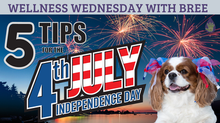Small Dog Syndrome - What To Do?
This past weekend was our 12th Annual Rattlesnake Avoidance Training, we trained over 200 dogs, over two days, with two trainers, a snake handler, and myself and one other gal doing check-in. Needless to say, it was a BIG weekend for everyone...the owners, the dogs, and those of us working.
My point to sharing this is when you get that many dogs over a short period of time you get to witness some exceptional behavior and some not so exceptional behavior.
Yep, you guessed it! We are going to talk about the not so exceptional behavior, and this is specifically about little dogs.
Many little dogs somehow get a pass, when it comes to acting like little tyrants. Some call it "Small Dog Syndrome" (which really isn't a thing), but it does put a label on the dog as to what is going on with them.
Heck, even I let Reckon get away with more than I would an 80lb Rottweiler. We as a society are just programmed that way, but that does not make it right.
Before I dive in, let's set the standard about what I am talking about. I am talking about handling skills, not just petting. So, what is the difference?
Petting is about stroking the dog in a way that is pleasurable to the dog. Many times, the dog solicits the behavior from us.
Handling is different, it includes inspecting the dog, manipulating the body parts, and moving the dog physically.
Examples of handling include the need to put a collar on, baths, vet visits, putting on a dog coat, pulling off the couch, picking them up, moving the dog from one spot to the next, picking up a dog and holding them. All things that are not solicited by the dog and many are not enjoyable so they are not reinforcing for the dog to comply.
Handling can cause frustration in dogs of all sizes, we just tend to push harder when the dog is small since we can overpower them with our size. This can cause frustration and even aggressive behavior when the dogs are put into this type of situation. Trust me it can get out of control pretty darn quick.
So what can you do?
Teach specific words and hand cues so that your dog will move on cue -vs- being physically managed.
Teach them to jump into your arms instead of reaching down to pick them up.
Teach a Hand Target (dogs touches nose to the palm of the hand, with reward) to move the dog from point A to B.
All of these behaviors can be simple to teach and can make all the difference in the world.
Now with that said, I still believe that additional work should be done to desensitize the dog to being properly and fairly handled, I will dive a little deeper on that on our Training Tribe Wednesday Reach Out coming to your inbox tomorrow. In my Reach Out, I will also share how you can work with me directly, even if you are not local.
Essential Oil for Dogs Spotlight:
When it comes to handling and our dog's desire to not be handled, I like to pull out the "big guns" for this one. My choice of oil would be Vetiver.
Vetiver is an oil that packs a big punch, it is my top choice when tackling some of the harder behavior modification cases that I work with. Vetiver has a sweet, woodsy, almost a smoky caramel scent. I personally really like it, as do 95% of the dogs that I work with.
It can be used topically, internally, and aromatically. Remember if your dog is new to oils, I recommend acclimation first, along with diffusing.
Vetiver has a very calming, grounding effect and helps the dogs stay under threshold when training and working on hard things.
Also great to use for yourself if you get stressed when working on this problem with your dog. A little for you, a little for them.
************************************
CONNECT WITH ME!
























Comentarios